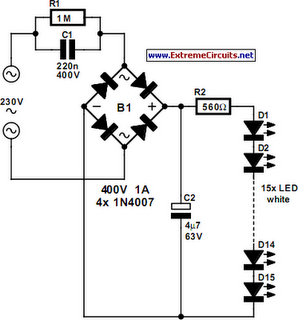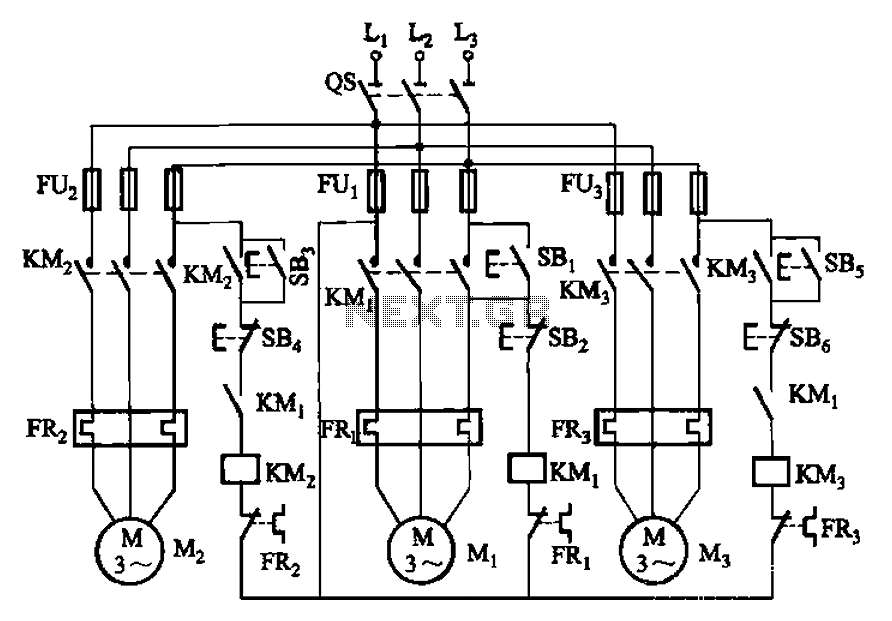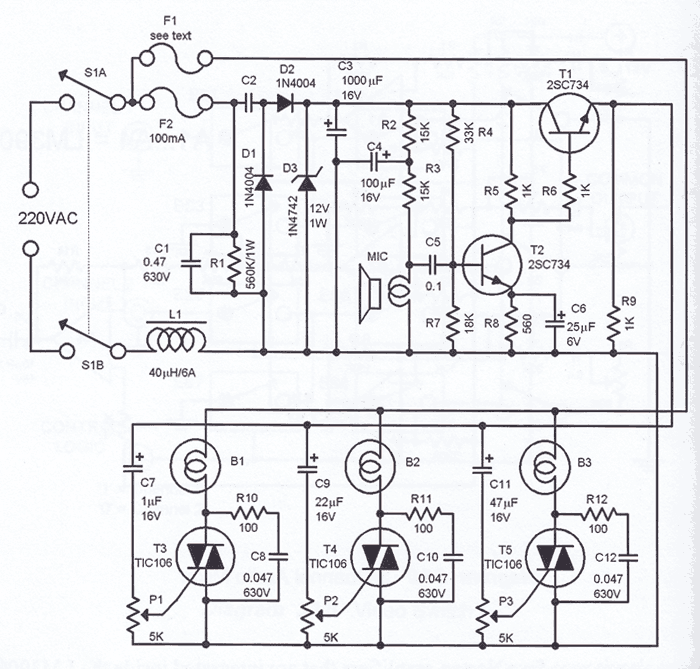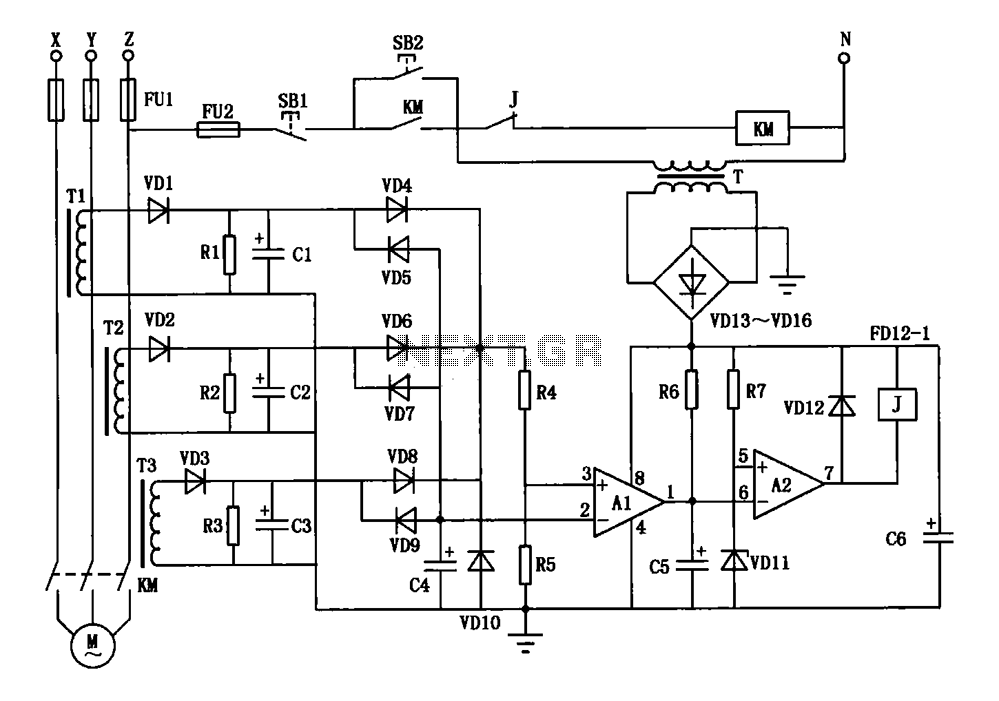
AD594 to a 597 basic application circuit
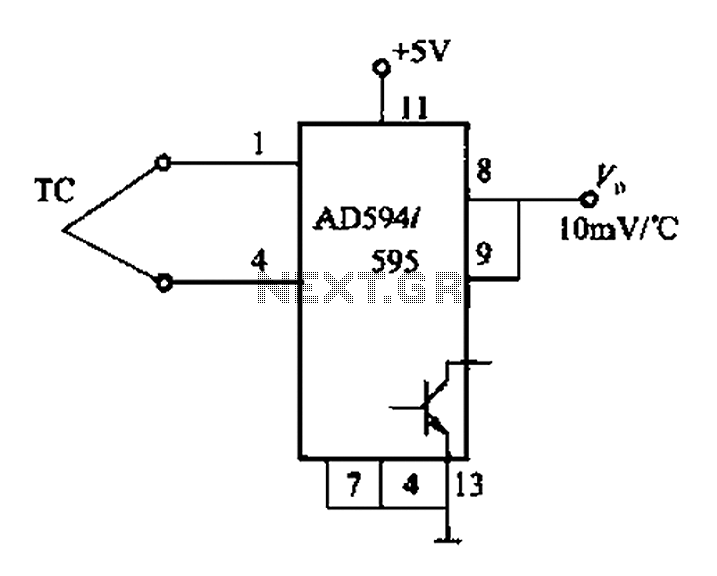
The AD594/595 series describes the relationship between output temperature and thermocouple voltage. For the AD594, the output voltage (Vo) is calculated using the formula: Vo = (VoJ + 16 μV) × 193.4 (mV), where VoJ represents the output voltage of a J-type thermocouple. In the case of the AD595, the formula is: Vo = (VOK + 11 μV) × 247.3 (mV), where VOK is the output voltage for a K-type thermocouple. The AD596/597 series also relates to output temperature. For the AD596, the output voltage is given by: Vo = (VoJ + 301.5 μV) × 180.57 (mV), while for the AD597, it is: Vo = VOK × 245.46 (mV). The circuits for the AD594 to AD597 allow for adjustment of the input and output pin hysteresis (HYS). The basic application circuit for the AD594/595 involves connecting the thermocouple directly to the integrated circuit (IC) with a single +5V power supply. This setup can provide an output of approximately 10 mV/°C, enabling measurement of temperatures from 0 to +300°C. The AD596/597 application circuit includes additional hysteresis regulation components (R1, RPi) and a temperature alarm indicator (LED). The RPi can adjust the output voltage difference, where each additional 200 nA of current increases the output temperature by 1 mV/°C. The temperature range for this series is also 0 to 300°C, with an accuracy of ±0.02°C from +25°C to +100°C.
The AD594/595 and AD596/597 series are integrated circuits designed for interfacing with thermocouples, specifically J-type and K-type thermocouples. The output voltage formulas for each IC provide a linear relationship between the thermocouple voltage and the corresponding temperature, allowing for precise temperature measurements.
In practical applications, the AD594 and AD595 circuits are typically powered by a single +5V supply, which simplifies the design and reduces the number of power supply requirements. The direct connection of the thermocouple to the IC enhances measurement accuracy by minimizing potential noise and signal degradation.
The hysteresis adjustment feature is crucial in applications where temperature stability is essential, such as in control systems or alarm circuits. By incorporating resistors R1 and RPi, users can fine-tune the hysteresis effect, ensuring that the output voltage does not fluctuate unnecessarily around the set point, which could lead to false readings or alarms.
The temperature alarm indicator LED serves as a visual cue, alerting users to temperature conditions that exceed predefined thresholds. This is particularly useful in industrial settings or environments where immediate action may be required in response to temperature changes.
Overall, the AD594, AD595, AD596, and AD597 series provide robust solutions for temperature measurement and control using thermocouples, with features that enhance usability and accuracy in a variety of applications.AD594/595 and the relationship between the output temperature is: AD594: Vo (Voj + 16pLV) x193.4 (mV) Where: voJ J-type thermocouple output voltage. AD595: Vo (VOK + llIr, V) x 247.3 (mV) Where: vol (for the K-type thermocouple output voltage. AD596/597 and the relationship between the output temperature is: AD596: Vo (VoJ + 301.5yV ) x180.57 (mV) where: voJ J-type thermocouple output voltage. AD597: Vo VOK x245.46 (mV) where: VOK a K-type thermocouple output voltage. adjust the input and output pin HYS hysteresis. AD594 ~ 597 basic application circuit is shown. when the AD594/595 circuit, the thermocouple is connected directly to the lC, single + 5v power supply, can easily obtain vo rxlOmV/C (r thermoelectric the measured temperature) even the sense of output, temperature range of O ~ + 300qC; in AD596/597 basic application circuit, increasing the hysteresis regulatory elements R1- ink, RPi and temperature alarm indicator LED, RPi can adjust the output back to the voltage difference, feet for each additional 200 nA current, output will increase the temperature of 1 hysteresis output voltage vo rx lOmV gate C (r thermocouple temperature), temperature range of O-300C, accuracy is t0.020C (+25 a + lOOoC).
The AD594/595 and AD596/597 series are integrated circuits designed for interfacing with thermocouples, specifically J-type and K-type thermocouples. The output voltage formulas for each IC provide a linear relationship between the thermocouple voltage and the corresponding temperature, allowing for precise temperature measurements.
In practical applications, the AD594 and AD595 circuits are typically powered by a single +5V supply, which simplifies the design and reduces the number of power supply requirements. The direct connection of the thermocouple to the IC enhances measurement accuracy by minimizing potential noise and signal degradation.
The hysteresis adjustment feature is crucial in applications where temperature stability is essential, such as in control systems or alarm circuits. By incorporating resistors R1 and RPi, users can fine-tune the hysteresis effect, ensuring that the output voltage does not fluctuate unnecessarily around the set point, which could lead to false readings or alarms.
The temperature alarm indicator LED serves as a visual cue, alerting users to temperature conditions that exceed predefined thresholds. This is particularly useful in industrial settings or environments where immediate action may be required in response to temperature changes.
Overall, the AD594, AD595, AD596, and AD597 series provide robust solutions for temperature measurement and control using thermocouples, with features that enhance usability and accuracy in a variety of applications.AD594/595 and the relationship between the output temperature is: AD594: Vo (Voj + 16pLV) x193.4 (mV) Where: voJ J-type thermocouple output voltage. AD595: Vo (VOK + llIr, V) x 247.3 (mV) Where: vol (for the K-type thermocouple output voltage. AD596/597 and the relationship between the output temperature is: AD596: Vo (VoJ + 301.5yV ) x180.57 (mV) where: voJ J-type thermocouple output voltage. AD597: Vo VOK x245.46 (mV) where: VOK a K-type thermocouple output voltage. adjust the input and output pin HYS hysteresis. AD594 ~ 597 basic application circuit is shown. when the AD594/595 circuit, the thermocouple is connected directly to the lC, single + 5v power supply, can easily obtain vo rxlOmV/C (r thermoelectric the measured temperature) even the sense of output, temperature range of O ~ + 300qC; in AD596/597 basic application circuit, increasing the hysteresis regulatory elements R1- ink, RPi and temperature alarm indicator LED, RPi can adjust the output back to the voltage difference, feet for each additional 200 nA current, output will increase the temperature of 1 hysteresis output voltage vo rx lOmV gate C (r thermocouple temperature), temperature range of O-300C, accuracy is t0.020C (+25 a + lOOoC).
Warning: include(partials/cookie-banner.php): Failed to open stream: Permission denied in /var/www/html/nextgr/view-circuit.php on line 713
Warning: include(): Failed opening 'partials/cookie-banner.php' for inclusion (include_path='.:/usr/share/php') in /var/www/html/nextgr/view-circuit.php on line 713
